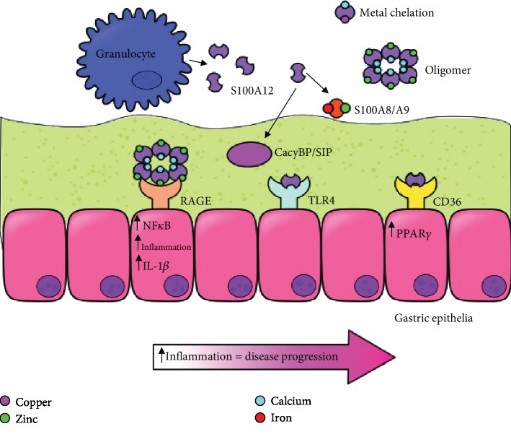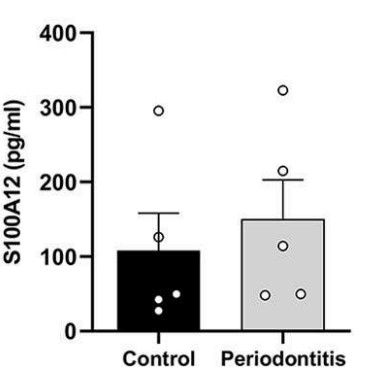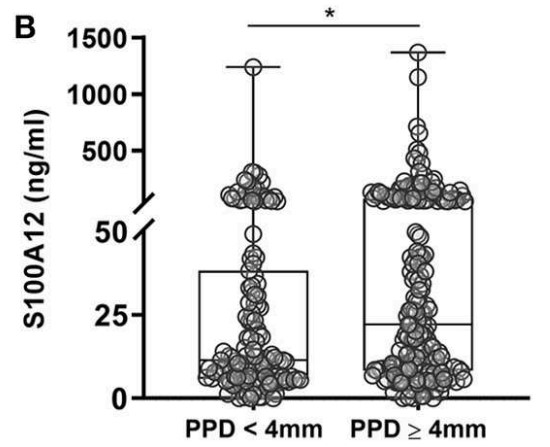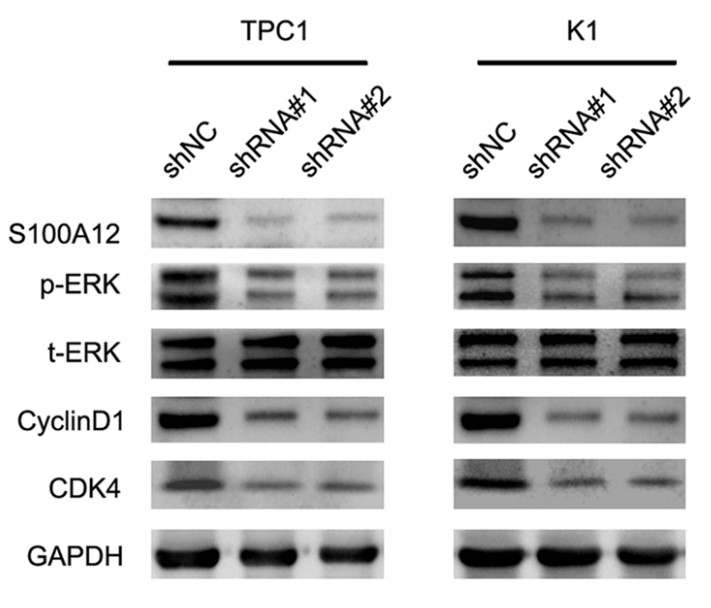S100A12
-
Official Full Name
S100 calcium binding protein A12 -
Overview
The protein encoded by this gene is a member of the S100 family of proteins containing 2 EF-hand calcium-binding motifs. S100 proteins are localized in the cytoplasm and/or nucleus of a wide range of cells, and involved in the regulation of a number of cellular processes such as cell cycle progression and differentiation. S100 genes include at least 13 members which are located as a cluster on chromosome 1q21.This protein is proposed to be involved in specific calcium-dependent signal transduction pathways and its regulatory effect on cytoskeletal components may modulate various neutrophil activities. -
Synonyms
S100A12;S100 calcium binding protein A12;S100 calcium binding protein A12 (calgranulin C) , S100 calcium binding protein A12 (calgranulin C);protein S100-A12;CAAF1;CAGC;CGRP;ENRAGE;MRP6;p6;Calcitermin;Calcium binding protein in amniotic fluid;Calcium-binding protein in amniotic fluid 1;Calgranulin C;Calgranulin related protein;Calgranulin-C;EN RAGE;EN-RAGE;Extracellular newly identified RAGE binding protein;Extracellular newly identified RAGE-binding protein;Neutrophil S100 protein;Protein S100 A12;S100 calcium-binding protein A12;S10AC_HUMAN;OTTHUMP00000015332;S100 calcium-binding protein A12 (calgranulin C)
Recombinant Proteins
- Human
- Cattle
- Pig
- Rabbit
- E.coli
- HEK293
- Yeast
- Baculovirus
- Mammalian cells
- Mammalian Cells
- GST
- Non
- His
- T7
- Fc
- DDK
- Myc
- Avi
- Flag
Background
What is S100A12 protein?
S100A12 (S100 calcium binding protein A12) gene is a protein coding gene which situated on the short arm of chromosome 1 at locus 1p33. The protein encoded by this gene is a member of the S100 family of proteins containing 2 EF-hand calcium-binding motifs. S100 proteins are localized in the cytoplasm and/or nucleus of a wide range of cells, and involved in the regulation of a number of cellular processes such as cell cycle progression and differentiation. This protein is proposed to be involved in specific calcium-dependent signal transduction pathways and its regulatory effect on cytoskeletal components may modulate various neutrophil activities. The protein includes an antimicrobial peptide which has antibacterial activity. The S100A12 protein is consisted of 92 amino acids and its molecular mass is approximately 10.6 kDa.
What is the function of S100A12 protein?
The S100A12 protein is a member of the S100 protein family, which is known for its ability to bind Ca2+ and transmit signals within cells. S100A12 plays a role in multiple biological processes, including cell proliferation, differentiation, migration, and apoptosis. It plays an important role in the inflammatory response and is involved in the regulation of immune response and inflammatory signaling pathways by interacting with a variety of cell types. S100A12 is also able to affect the course of the cell cycle, thereby affecting cell growth and survival. In addition, S100A12 also plays a key role in maintaining tissue homeostasis and repairing damage, especially in epithelial tissues and skin.
S100A12 Related Signaling Pathway
S100A12 plays a key role in inflammation by binding to the advanced glycosylation end-product receptor (RAGE) and activating the downstream NF-κB (nuclear factor κB) signaling pathway, thereby promoting the expression of inflammatory cytokines and the occurrence of inflammatory cascades. S100A12 also plays a role in cell proliferation and differentiation by interacting with different cell surface receptors, such as TLR4 (Toll-like receptor 4) and CD36, to promote cell signaling and changes in cell behavior.
S100A12 Related Diseases
S100A12 plays an important role in inflammatory diseases, especially during the formation and rupture of atherosclerosis (AS), and the expression level of S100A12 is positively correlated with the severity of the disease. In addition, S100A12 has been implicated in acute coronary syndromes (ACS), and changes in its level may be related to the molecular mechanism by which angina progresses to myocardial infarction. In the study of pulmonary hypertension (PAH), S100A12 has been found to be potentially involved in the development of the disease, affecting pulmonary vascular function. In myocardial ischemia-reperfusion (MI/R) injury, S100A12 is also considered to be a key factor affecting mitochondrial function, inflammatory response and calcium overload of cardiomyocytes. In addition, S100A12 acts as a marker of inflammation in acute exacerbation of chronic obstructive pulmonary disease (AECOPD), and its level correlates with the severity of the condition. In idiopathic pulmonary fibrosis (IPF), S100A12 is considered to be a prognostic biomarker, but its specific correlation with IPF needs further study.

Fig1. Conceptual diagram of the association of S100A12 in various digestive diseases and health. (Alexandre Carvalho, 2020)
Bioapplications of S100A12
S100A12 is a marker of inflammatory response, and its levels are significantly elevated in infections, inflammatory diseases, and other pathological states. Therefore, it can be used to diagnose and monitor these diseases. Because S100A12 plays a key role in a variety of diseases, it is considered a promising drug target. Small molecule inhibitors or antibodies targeting S100A12 may help treat related diseases. It plays an important role in a variety of diseases and is considered a good model for disease pathogenesis research.
Case Study
Case Study 1: Ronaldo Lira-Junior, 2020
S100A12 is a calcium-binding protein of the S100 subfamily of myeloid-related proteins that acts as an alarmin to induce a pro-inflammatory innate immune response. It has been linked to several chronic inflammatory diseases, however its role in the common oral immunopathology periodontitis is largely unknown. Previous in vitro monoculture experiments indicate that S100A12 production decreases during monocyte differentiation stages, while the regulation within tissue is poorly defined. This study evaluated S100A12 expression in monocyte subsets, during monocyte-to-macrophage differentiation and following polarization, both in monoculture and in a tissue context, utilizing a three-dimensional co-culture oral tissue model. Further, the researchers explored the involvement of S100A12 in periodontitis by analyzing its expression in peripheral circulation and gingival tissue, as well as in saliva. The results showed that S100A12 expression was higher in classical than in non-classical monocytes. S100A12 expression and protein secretion declined significantly during monocyte-to-macrophage differentiation, while polarization of monocyte-derived macrophages had no effect on either. Peripheral monocytes from periodontitis patients had higher S100A12 expression than monocytes from controls, a difference particularly observed in the intermediate and non-classical monocyte subsets. Likewise, S100A12 expression was higher in gingival tissue from periodontitis patients where monocyte-derived cells exhibited higher expression of S100A12 in comparison to non-periodontitis tissue.

Fig1. S100A12 levels in plasma from periodontitis patients (n = 5) and controls (n = 5).

Fig2. Salivary levels of S100A12 in participants having (n = 201) or not probing pocket depth (PPD) ≥ 4 mm (n = 135).
Case Study 2: Xiaojie Wang, 2020
S100A12 belongs to the S100 family and acts as a vital regulator in different types of tumors. However, the function of S100A12 in thyroid carcinoma has not yet been investigated. This study analyzed the expression of S100A12 in human papillary thyroid cancer (PTC) samples and two PTC cell lines. In addition, the researchers explored the effects of S100A12 on PTC cell progression in vitro and in vivo. The results showed that S100A12 was significantly upregulated in PTC specimens. Moreover, silencing S100A12 markedly inhibited PTC cell proliferation, migration, invasion and cell cycle progression. In addition, knockdown of S100A12 significantly reduced the expression of CyclinD1, CDK4 and p-ERK in PTC cells. An in vivo study also showed that silencing S100A12 dramatically suppressed tumor cell growth and decreased Ki67 expression in a xenograft mouse model. Knockdown of S100A12 suppressed PTC cell proliferation, migration, and invasion and induced G0/G1 phase arrest via the inhibition of the ERK signaling pathway.

Fig3. Western blotting of S100A12 expression in paired PTC tissues(T) and their adjacent noncancerous tissues(N).

Fig4. Western blot analysis of the expression levels of p-ERK,t-ERK,CyclinD1 and CDK4, in TPC1 and K1, after silencing S100A12.
Quality Guarantee
Involved Pathway
S100A12 involved in several pathways and played different roles in them. We selected most pathways S100A12 participated on our site, such as Activated TLR4 signalling,Advanced glycosylation endproduct receptor signaling,Cytosolic sensors of pathogen-associated DNA, which may be useful for your reference. Also, other proteins which involved in the same pathway with S100A12 were listed below. Creative BioMart supplied nearly all the proteins listed, you can search them on our site.
| Pathway Name | Pathway Related Protein |
|---|---|
| MyD88 cascade initiated on plasma membrane | DHX9,PELI2,PELI1,TNIP2,PELI3,S100B,ALCAMB,TLR10,AGER,DUSP3B |
| Cytosolic sensors of pathogen-associated DNA | POLR3C,ALCAMB,APPB,RIPK3,IFI16,TRIM56,MB21D1,POLR3GLA,POLR3F,CHST13 |
| MyD88 dependent cascade initiated on endosome | CHST13,S100B,ALCAMB,DHX9 |
| DEx/H-box helicases activate type I IFN and inflammatory cytokines production | AGER,DHX9,S100B,APPB,SAA1,APPA,CHST13,ALCAMB |
| Advanced glycosylation endproduct receptor signaling | S100B,APPB,ALCAMB,AGER,DDOST,SAA1,APPA,LGALS3 |
| Innate Immune System | TREX1,CTSLL,TXNIPB,CRCP,ABI1,GZMM,MAP3K8,DEFA3,CASP2,CD300E |
| Immune System | LILRB2,RNF123,UBE2J2,CTSH,KPNA5,KIF20A,TRIM68,DCTN6,VPRBP,KLRF1 |
| Activated TLR4 signalling | DHX9,CREB1B,APPA,TICAM1,AGER,S100B,JUN,DUSP3,IRAK3,SAA1 |
Protein Function
S100A12 has several biochemical functions, for example, RAGE receptor binding,calcium ion binding,copper ion binding. Some of the functions are cooperated with other proteins, some of the functions could acted by S100A12 itself. We selected most functions S100A12 had, and list some proteins which have the same functions with S100A12. You can find most of the proteins on our site.
| Function | Related Protein |
|---|---|
| zinc ion binding | ADH4,RC3H2,DTX3L,UBR1,DTX4,LIN28B,SNCA,CSRP1B,ADAM12,KLF7 |
| RAGE receptor binding | S100B,S100A8,S100A9,S100A13,HMGB2,S100P,FPR1,S100A7,HMGB1,S100A4 |
| copper ion binding | DBH,HEPH,LOXL1,P2RX2,TYRP1,METTL17,POLR1B,HEPHL1A,TYRP1B,IL1A |
| protein binding | SH3YL1,PSG1,HTR3E,PRDX4,TOR1B,DUSP21,SNX20,FBXL3,MAT2A,COL17A1 |
| calcium ion binding | PCDH18A,ACTN3A,CBLB,CALB1,CDH8,THBD,PCDHA2,DLA,LRP2,CAPSLB |
Interacting Protein
S100A12 has direct interactions with proteins and molecules. Those interactions were detected by several methods such as yeast two hybrid, co-IP, pull-down and so on. We selected proteins and molecules interacted with S100A12 here. Most of them are supplied by our site. Hope this information will be useful for your research of S100A12.
thrC
Resources
Related Services
Related Products
References
- Zhan, YC; Zhang, F; et al. Potential Effects of Calcium Binding Protein S100A12 on Severity Evaluation and Curative Effect of Severe Acute Pancreatitis. INFLAMMATION 38:290-297(2015).
- Ahmed, U; Thornalley, PJ; et al. Possible role of methylglyoxal and glyoxalase in arthritis. BIOCHEMICAL SOCIETY TRANSACTIONS 42:538-542(2014).


.jpg)
.jpg)

